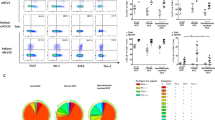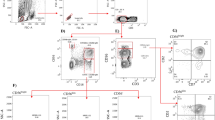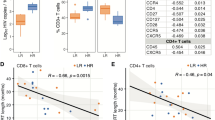Abstract
The ability to rapidly identify immune cell subsets such as CD4 cells, which became possible around the same time as the onset of the HIV/AIDS pandemic, was one of the greatest advances in clinical and diagnostic immunology. The evolution of this global pandemic and the subsequent development of treatment strategies to prolong the life of infected individuals mean that it is now more crucial than ever that we develop affordable, reliable and accurate methods for the enumeration of CD4 cells. Here, we provide an overview of the historical developments in CD4 enumeration technologies that are related to HIV infection, and summarize the current technological challenges that must be overcome to meet the needs of those living with HIV infection.
This is a preview of subscription content, access via your institution
Access options
Subscribe to this journal
Receive 12 print issues and online access
$209.00 per year
only $17.42 per issue
Buy this article
- Purchase on Springer Link
- Instant access to full article PDF
Prices may be subject to local taxes which are calculated during checkout


Similar content being viewed by others
References
Gottlieb, M. S. et al. Pneumocystis carinii pneumonia and mucosal candidiasis in previously healthy homosexual men: evidence of a new acquired cellular immunodeficiency. N. Engl. J. Med. 305, 1425–1431 (1981).
Masur, H. et al. An outbreak of community-acquired Pneumocystis carinii pneumonia: initial manifestation of cellular immune dysfunction. N. Engl. J. Med. 305, 1431–1438 (1981).
Siegal, F. P. et al. Severe acquired immunodeficiency in male homosexuals, manifested by chronic perianal ulcerative herpes simplex lesions. N. Engl. J. Med. 305, 1439–1444 (1981).
Ammann, A. J. et al. Acquired immune dysfunction in homosexual men: immunologic profiles. Clin. Immunol. Immunopath. 27, 315–325 (1983).
Schroff, R. W., Gottlieb, M. S., Prince, H. E., Chai, L. L. & Fahey, J. L. Immunological studies of homosexual men with immunodeficiency and Kaposi's sarcoma. Clin. Immunol. Immunopathol. 27, 300–314 (1983).
Barré-Sinoussi, F. et al. Isolation of a T-lymphotropic retrovirus from a patient at risk for acquired immune deficiency syndrome (AIDS). Science 220, 868–871 (1983).
Popovic, M., Sarngadharan, M. G., Read, E. & Gallo, R. C. Detection, isolation, and continuous production of cytopathic retroviruses (HTLV-III) from patients with AIDS and pre-AIDS. Science 224, 497–500 (1984).
McDougal, J. S. et al. Binding of HTLV-III/LAV to T4+ T cells by a complex of the 110K viral protein and the T4 molecule. Science 231, 382–385 (1986).
Margolick, J. B. et al. Decline in total T cell count is associated with onset of AIDS, independent of CD4(+) lymphocyte count: implications for AIDS pathogenesis. Clin. Immunol. Immunopathol. 88, 256–263 (1998).
Kohler, G., Howe, S. C. & Milstein, C. Fusion between immunoglobulin-secreting and nonsecreting myeloma cell lines. Eur. J. Immunol. 6, 292–295 (1976).
Kohler, G. & Milstein, C. Continuous cultures of fused cells secreting antibody of predefined specificity. Nature 256, 495–497 ( 1975).
Janossy, G. in Methods in Hematology The Leukemic Cell (ed. Catovsky, D.)129–183 (Churchill Livingstone, London, 1981).
Giorgi, J. V. Characterization of T lymphocyte subset alterations by flow cytometry in HIV disease. Ann. New York Acad. Sci. 677, 126–137 (1993).
Giorgi, J. V. & Detels, R. T-cell subset alterations in HIV-infected homosexual men: NIAID Multicenter AIDS cohort study. Clin. Immunol. Immunopath. 52, 10–18 (1989).
Coulter, W. H. High speed automatic blood cell counter and analyser. Proc. Soc. Exp. Biol. Med. 12, 1034–1035 (1954).
Kamentsky, L. A., Melamed, M. R. & Derman H. Spectrophotometer: new instrument for ultrarapid cell analysis. Science 150, 630–631 (1965).
Kamentsky, L. A. & Melamed, M. R. Spectrophotometric cell sorter. Science 156, 1364–1365 (1967).
Loken, M. R., Brosnan, J. M., Bach, B. A. & Ault, K. A. Quality control in flow cytometry: 1: Establishing optimal lymphocyte gates for immunophenotyping by flow cytometry. Cytometry 11, 453–459 (1990).
CDC. Guidelines for the performance of CD4+ T-cell determinations in persons with human immunodeficiency virus infection. MMWR 41, 1–19 (1992).
Barnett, D., Granger, V., Whitby, L, Storie, I. & Reilly, J. T. Absolute CD4+ T-lymphocyte and CD34+ stem cell counts by single platform flow cytometry: The way forward. Br. J. Haematol. 106, 1059–1062 (1999).
Robinson, G. et al. Effect of type of haematology analyser on CD4 count. Lancet. 340, 485 (1992).
Bergeron, M. et al. Selection of lymphocyte gating protocol has an impact on the level of reliability of T-cell subsets in aging specimens. Cytometry 50, 53–61 (2002).
Glencross, D., Scott, L.E., Jani, I.V., Barnett, D. & Janossy, G. CD45-assisted PanLeucogating for accurate, cost-effective dual-platform CD4+ T-cell enumeration. Cytometry 50, 69–77 (2002).
Mandy, F. F., Bergeron, M., Recktenwald, D. & Izaguirre, C. A. A simultaneous three-color T cell subsets analysis with single laser flow cytometers using T cell gating protocol. Comparison with conventional two-color immunophenotyping method. J. Immunol. Meth. 156, 151–162 (1992).
Nicholson, J. K., Jones, B. M. & Hubbard, M. CD4 T-lymphocyte determinations on whole blood specimens using a single-tube three-color assay. Cytometry 14, 685–689 (1993).
Antiretroviral Therapy Cohort Collaboration. Importance of baseline prognostic factors with increasing time since initiation of highly active antiretroviral therapy: collaborative analysis of cohorts of HIV-1-infected patients. J. Acquir. Immune Defic. Syndr. 46, 607–615 (2007).
Lichtenstein, K. A. et al. Initiation of antiretroviral therapy at CD4 cell counts >/=350 cells/mm3 does not increase incidence or risk of peripheral neuropathy, anemia, or renal insufficiency. J. Acquir. Immune Defic. Syndr. 47, 27–35 (2008).
Gupta, S.B. et al., AIDS Society of India Guidelines Development Committee. API consensus guidelines or use of antiretroviral therapy in adults (API-ART guidelines). Endorsed by the AIDS Society of India. J. Assoc. Physicians India 54, 57–74 (2006).
Dybul, M. et al. Panel on Clinical Practices for the Treatment of HIV. Guidelines for using antiretroviral agents among HIV-infected adults and adolescents. Recommendations of the Panel on Clinical Practices for Treatment of HIV. MMWR Recomm. Rep. 51 (RR-7), 1–55 (2002).
Iribarren, J. A. et al. Spanish GESIDA/Nacional AIDS Plan Recommendations for antiretroviral therapy in HIV-infected Adults (October 2004). Enferm. Infecc. Microbiol. Clin. 22, 561–563 (2004).
Hammer, S. M. et al. International AIDS Society-USA panel. Treatment for adult HIV infection: 2006 recommendations of the International AIDS Society-USA panel. JAMA 296, 827–843 (2006).
Beck, E. J. et al. National adult antiretroviral therapy guidelines in resource-limited countries: concordance with 2003 WHO guidelines? AIDS 20, 1497–1502 (2006).
Gazzard, B. on behalf of the BHIVA Writing Committee. British HIV Association (BHIVA) guidelines for the treatment of HIV-infected adults with antiretroviral therapy (2006). HIV Med. 7, 487–503 (2006).
Opravil, M. et al. Clinical efficacy of early initiation of HAART in patients with asymptomatic HIV infection and CD4 cell count >350 x 106/l. AIDS 16, 1371–1381 (2002).
UNAIDS. 2008 report on the global AIDS epidemic <[online]>, (UNAIDS, Geneva, Switzerland, 2008).
Médecins Sans Frontières. Untangling the web of price reductions: a pricing guide for the purchase of ARVs for developing countries <[online]>, (MSF, 2007).
Bennett, D. E., Myatt, M., Bertagnolio, S., Sutherland, D. & Gilks, C. F. Recommendations for surveillance of transmitted HIV drug resistance in countries scaling up antiretroviral treatment. Antiviral Ther. 13, 25–36 (2008).
Huang, K. H., Loutfy, M. R., Tsoukas, C. M. & Bernard, N. F. Immune correlates of CD4 decline in HIV-infected patients experiencing virologic failure before undergoing treatment interruption. BMC Infect. Dis. 8, 59 (2008).
Bushman, F., Landau, N. R. & Emini, E. A. New developments in the biology and treatment of HIV. Proc. Natl Acad. Sci. USA 95, 11041–11042 (1998).
Casado, J. L. et al. Predictors of long-term response to protease inhibitor therapy in a cohort of HIV-infected patients. AIDS 12, 131–135 (1998).
Dieye, T. N. et al. Spontaneous apoptosis and highly active antiretroviral therapy (HAART). Biomed. Pharmacother. 54, 16–20 (2000).
Dyrhol-Riise, A. M., Voltersvik, P., Rosok, B. I., Olofsson, J. & Asjo, B. Normalization of CD4+ cell numbers and reduced levels of memory CD8+ cells in blood and tonsillar tissue after highly active antiretroviral therapy in early HIV type-1 infection. AIDS Res. Hum. Retrovir. 16, 191–201 (2000).
Evans, T. G. et al. Highly active antiretroviral therapy results in a decrease in CD8+ T cell activation and preferential reconstitution of the peripheral CD4+ T cell population with memory rather than naive cells. Antiviral Res. 39, 163–173 (1998).
Fessel, W. J. et al. Dissociation of immunologic and virologic responses to highly active antiretroviral therapy. J. Acquir. Immune Defic. Syndr. 23, 314–320 (2000).
Jacobson, L. P. et al. Changes in survival after acquired immunodeficiency syndrome (AIDS): 1984–1991. Am. J. Epidemiol. 138, 952–964 (1993).
Pandolfi, F. et al. The Italian quality control study for evaluation of CD4 cells in centres involved in the treatment of HIV-1 patients. Clin. Exp. Immunol. 111, 564–573 (1998).
Peter, K. & Gambertoglio, J. G. Zidovudine phosphorylation after short-term and long-term therapy with zidovudine in patients infected with the human immunodeficiency virus. Clin. Pharmacol. Ther. 60, 168–176 (1996).
Erkellor-Yuksel, F. M. et al. Age-related changes in human blood lymphocyte subpopulations. J. Pediatr. 120, 216–222 (1992).
Denny, T. et al. Lymphocyte subsets in healthy children during the first 5 years of life. JAMA 267, 1484–1488 (1992).
Giorgi, J. V., et al. in Manual of Clinical Laboratory Immunology (4th ed) (eds Rose N. R. et al.) 174–181 (ASM Press, Washington, D.C., USA, 1992).
Stiehm, E. R. in Immunologic Disorders in Infants and Children (4th ed) (eds Stiehm, E. R., Ochs, H. & Winkelstein, J.) 217 (W.B. Saunders Company, Philadelphia, 1996).
Bofill, M. et al. Laboratory control values for CD4 and CD8 T lymphocytes. Implications for HIV-1 diagnosis. Clin. Exp. Immunol. 88, 243–252 (1992).
CDC. Revised classification system for HIV infection and expanded surveillance case definition for AIDS among adolescents and adults. MMWR 41, 1–35 (1993).
Fahey, J. L. et al. The prognostic value of cellular and serologic markers in infection with human immunodeficiency virus type 1. N. Engl. J. Med. 322, 166–172 (1990).
Nicholson, J. K. A. Immunophenotyping specimens from HIV-infected persons: laboratory guidelines from the Centers for Disease Control and Prevention. Cytometry 18, 55–59 (1994).
Kaplan, J. E., Masur, H., & Holmes, King, K. K. Criteria for starting, discontinuing, and restarting opportunistic infection prophylaxis for adults with human immunodeficiency virus infection, Recommendations of the U.S. Public Health Service and the Infectious Diseases Society of America. MMWR Recomm. Rep. 51(RR08), 1–46 (2002).
WHO. Guidelines on co-trimoxazole prophylaxis for HIV-related infections among children, adolescents, and adults: Recommendations for a public health approach. <[online]>, (WHO, Geneva, Switzerland, 2006).
Moss, A. R. & Bacchetti, P. Natural history of HIV infection. AIDS 3, 55–61 (1989).
Mellors, J. W. et al. Plasma viral load and CD4+ lymphocytes as prognostic markers of HIV-1 infection. Ann. Int. Med. 126, 946–954 (1997).
Moss, A. R. et al. Risk factors for AIDS and HIV seropositivity in homosexual men. Am. J. Epidemiol. 125, 1035–1047 (1987).
Herbeck, J. T. et al. Lack of evidence for changing virulence of HIV-1 in North America. PLoS One 3, e1525 (2008).
Spira, T. J. et al. Unexplained opportunistic infections and CD4 T lymphocytopenia: an analysis of five cases. N. Engl. J. Med. 328, 386–392 (1993).
Smith, D. K. et al. CDC Idiopathic CD4 T Lymphocytopenia (ICL) Task Force. Unexplained opportunistic infections and CD4 T lymphocytopenia in persons without HIV infection, United States. N. Engl. J. Med. 328, 373–379 (1993).
Strauss, K. et al. Performance evaluation of the FACSCount System: a dedicated system for clinical cellular analysis. Cytometry 26, 52–59 (1996).
Spacek, L. A. et al. Evaluation of a low-cost method, the Guava EasyCD4 assay, to enumerate CD4-positive lymphocyte counts in HIV-infected patients in the United States and Uganda. J. Acquir. Immune Defic. Syndr. 41, 607–610 (2006).
Thakar, M. R., Kumar, B. K., Mahajan, B. A., Mehendale, S. M. & Paranjape, R. S. Comparison of capillary based microflurometric assay for CD4+ T cell count estimation with dual platform Flow cytometry. AIDS Res. Ther. 3, 26 (2006).
Balakrishnan, P. et al. An inexpensive, simple, and manual method of CD4 T-cell quantitation in HIV-infected individuals for use in developing countries. J. Acquir. Immune Defic. Syndr. 36, 1006–1010 (2004).
Yari, A. et al. SMARThivCD4mos: A complexity-free and cost effective model technology for monitoring HIV patients CD4 number in resource-poor settings. Bioinformation 2, 257–259 (2008).
Lutwama, F. et al. Evaluation of Dynabeads and Cytospheres compared with flow cytometry to enumerate CD4+ T cells in HIV-infected Ugandans on antiretroviral therapy. J. Acquir. Immune Defic. Syndr. 48, 297–303 (2008).
Whitby, L. et al. Quality control of CD4+ T-lymphocyte enumeration: results from the last nine years of the United Kingdom External Quality Assurance Scheme for Immune Monitoring (1993-2001). Cytometry 50, 102–110 (2002).
Brando, B. et al. Cytoflourometric methods for assessing absolute numbers of cells subsets in blood. Cytometry 42, 327–346 (2000).
O'Gorman, M. R. & Nicholson, J. K. A. Adoption of single-platform technologies for enumeration of absolute T-lymphocyte subsets in peripheral blood. Clin. Diag. Lab. Immunol. 7, 333–335 (2000).
Schnizlein-Bick, C. T. et al., DAIDS/NIAID New Technology Evaluation Group. Evaluation of TruCount absolute count tubes for determining CD4 and CD8 cell numbers in Human Immunodeficiency Virus-positive adults. Clin. Diag. Lab. Immunol. 7, 336–343 (2000).
Storie, I. et al. Flow rate calibration I: a novel approach for performing absolute cell counts. Cytometry 55, 1–7 (2003).
Storie, I. et al. Perfect count: a novel approach for the single platform enumeration of absolute CD4+ T-lymphocytes. Cytometry 57, 47–52 (2004).
Barnett, D. et al. Reduction of intra- and interlaboratory variation in CD34+ stem cell enumeration using stable test material, standard protocols and targeted training. DK34 Task Force of the European Working Group of Clinical Cell Analysis (EWGCCA). Br. J. Haematol. 108, 784–792 (2000).
Kunkl, A. et al. Grading of laboratories on CD4+ T-lymphocyte evaluations based on acceptable data boundaries defined by the measurement error. Cytometry 50, 117–126 (2002).
Barnett, D. & Denny, T. N. Lymphocyte immunophenotyping in Human Immunodeficiency virus infection: for richer, for poorer. Flow Cytometry 1–16 (2007).
Whitby, L., Granger, V., Walker, C., Reilly, J.T. & Barnett, D. The relative error of dual versus single platform technology for CD4+ T lymphocyte enumeration: the impact on clinical decision making (Abstract 42). Cytometry B Clin. Cytom. 68B, 69 (2005).
Mandy, F., Bergeron, M., Houle, G., Bradley, J. & Fahey, J. Impact of the international program for quality assessment and standardization for immunological measures relevant to HIV/AIDS: QASI. Cytometry 50, 111–116 (2002).
Denny, T. N. et al. A North American multilaboratory study of CD4 counts using flow cytometric panLeukogating (PLG): a NIAID-DAIDS Immunology Quality Assessment Program Study. Cytometry B Clin. Cytom. 74B (Suppl. 1), 52–64 (2008).
Glencross, D. K. et al. Large-scale affordable PanLeucogated CD4+ testing with proactive internal and external quality assessment: in support of the South African national comprehensive care, treatment and management programme for HIV and AIDS. Cytometry B Clin Cytom. 74B (Suppl. 1), 40–51 (2008).
Barnett, D. in Generic RTD Activities and Research Infrastructures FP5 1998-2002: Consolidated Report (ed. S. S. Baig) 510–511 (European Commission — Office for Official Publications of the European Community, Luxembourg, 2003).
Barnett, D. et al. Guidelines for the determination of CD4+ T lymphocytes in Immunosuppressed Individuals. Clin. Lab. Haematol. 19, 231–241 (1997).
CDC. 1994 revised guidelines for the performance of CD4+ T-cell determinations in persons with human immunodeficiency virus (HIV) infections. MMWR Recomm. Rep. 43 (RR-3), 1–21 (1994).
CDC. 1997 revised guidelines for performing CD4+ T-cell determinations in persons infected with human immunodeficiency virus (HIV). MMWR Recomm. Rep. 46 (RR-2), 1–29 (1997).
CDC. Guidelines for performing single-platform absolute CD4+ T-cell determinations with CD45 gating for persons infected with human immunodeficiency virus. MMWR Recomm. Rep. 52 (RR-2), 1–13 (2003).
UNAIDS/WHO. AIDS epidemic update <[online]>, (UNAIDS/WHO, Geneva, Switzerland, 2007).
Author information
Authors and Affiliations
Corresponding author
Rights and permissions
About this article
Cite this article
Barnett, D., Walker, B., Landay, A. et al. CD4 immunophenotyping in HIV infection. Nat Rev Microbiol 6 (Suppl 11), S7–S15 (2008). https://doi.org/10.1038/nrmicro1998
Issue Date:
DOI: https://doi.org/10.1038/nrmicro1998
This article is cited by
-
Modeling Negatively Skewed Survival Data in Accelerated Failure Time and Correlated Frailty Models
Journal of the Indian Society for Probability and Statistics (2024)
-
The reference ranges and characteristics of lymphocyte parameters and the correlation between lymphocyte parameters and routine health indicators in adults from China
Immunity & Ageing (2022)
-
Measurement of circulating CD21−CD27− B lymphocytes in SLE patients is associated with disease activity independently of conventional serological biomarkers
Scientific Reports (2022)
-
Evaluation of a collaborative model for successful implementation of a National CD4 enumeration EQA program in Cameroon
Scientific Reports (2021)
-
Validation of the BD FACSPresto system for the measurement of CD4 T-lymphocytes and hemoglobin concentration in HIV-negative and HIV-positive subjects
Scientific Reports (2020)



